The Life, Trials, and Execution of Mary Dyer: An Account
by Douglas O. Linder (2019)

Mary Dyer walking the mile to her execution site.
Mary Dyer was on a quest. Quests can give meaning to a life. They can also, sometimes, shape history. But quests do not always end well. For Mary Dyer, her spiritual quest took her from England to Boston to Rhode Island, back to England, where she became an ardent member of a new religion —a Quaker, or a member of the Society of Friends as they are now more formally known. Determined to spread the good news, Mary returned to New England as a Quaker missionary. Ultimately, Mary's public actions in support of her religious beliefs led her to the gallows on Boston Neck, the first woman executed in America for acting on her religious beliefs: Mary Dyer, "the Quaker Martyr."
Dyer’s story reveals much about the intolerance of colonial America in the mid-1600s. But Mary’s martyrdom also contributed to the birth of religious freedom in America. Her story is one of the most compelling stories of the seventeenth century, a time when America was defining itself and much was up for grabs.
Background
About 1611, near or in London, the woman who would become known as Mary Dyer was born Marie Barret Almost nothing is known of her parents, who seem to have died when Mary (as we will call he) was young. She had a brother, William, and was well-educated.
In 1633, Mary married William Dyer in St. Martin-in-the-Field church, Westminster. Although a member of the prestigious Fishmongers' Company, William had been an apprentice for nine years to an importer of fineries from Milan and had established his own business selling small wares. The economy in England was poor at the time, and puritans were being persecuted, so the Dyers explored their options. In the late summer of 1635, with Mary pregnant, the Dyers paid fifty pounds for passage and set sail for Boston.
They built a house on Summer Street. The couple slept on the main floor near the fireplace. They settled into Puritan life—a life of Bible reading, Church attending, importing and selling merchant wares, farming (they obtained 42 acres of meadow and woods outside Boston), and daily chores.
The Puritans were all about conformity and community. But the Dyers arrived in Boston just a schisms were developing. Salem minister Roger Williams was under attack for “dangerous opinions” about the land rights of Indians and separation of church and state. In October 1635, the General Court sentenced Williams to banishment from the Colony, giving him six weeks to leave.
The next year the Puritan divided over a theological question. Orthodox Puritan teaching, favored by Governor John Winthrop and most of the Puritan ministers, was coming under challenge from an unlikely source, a woman—in this, a society for which women had almost no role in the public space. (Women could not become ministers, could not speak in church, could not vote, and could play no formal role in governance of the colony.) Specifically, Anne Hutchinson, through increasingly popular discussion groups held in her home, suggested that many ministers had strayed from what she saw as the true teaching of the Bible, that salvation is a matter of grace, and were teaching instead what she called “a covenant of works”—that is, the idea that salvation depended upon one’s giving alms, praying, attending church, and doing good works.
A close friendship between Mary Dyer and Anne Hutchinson blossomed in 1636. Mary, and later her husband William, became regular attendees and Hutchinson’s religious lectures around a brick fireplace in her her large common room. Hutchinson’s fame and influence spread and, in May 1636, things seemed to be going her way when a supporter of hers, Harry Vane, won election as the colony’s new governor.
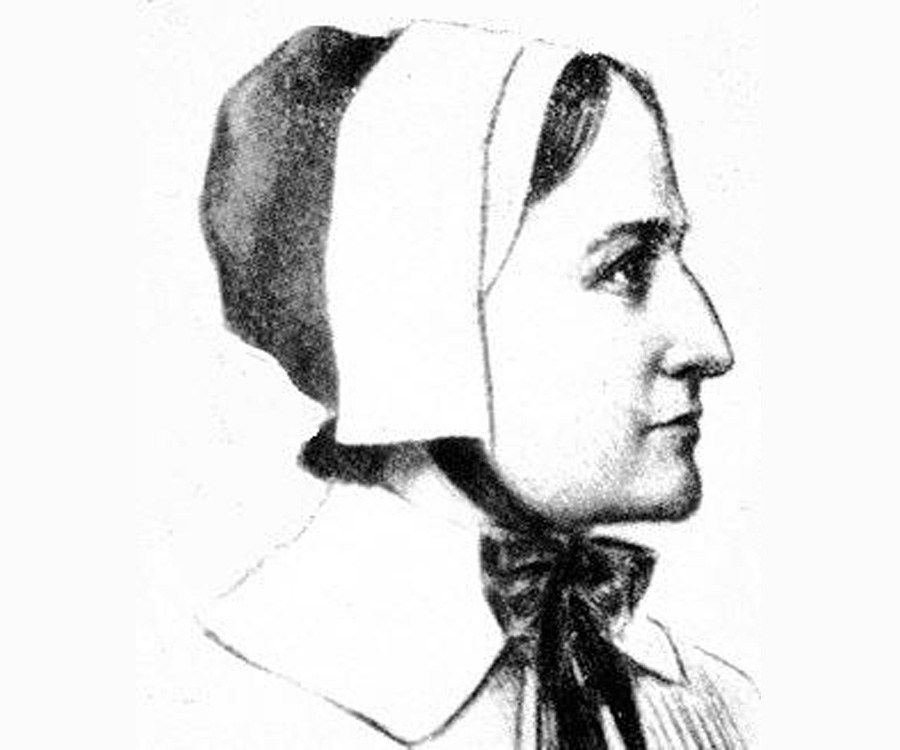
Anne Hutchinson
The next year, however, the fortunes of both Hutchinson and Dyer took a marked turn for the worse. It began in Newtowne (Cambridge) in May with John Winthrop being elected governor over Harry Vane. While Vane carried the votes of Boston freemen, Winthrop won on the strength of his vote in outlying areas. Winthrop made no secret of his distaste for what he saw as the troublesome Anne Hutchinson, and he wasted little time in turning the screws on her.
Mary Dyer faced a crisis of another sort in 1637. On October 17, in her seventh month of pregnancy, Mary began experiencing contractions. Her friend, Anne Hutchinson, was called for and Anne came to the Dyer home accompanied by midwife Jane Hawkins.
It was a hard labor and it did not end well. Mary’s daughter was stillborn and seriously deformed. Today, doctors would describe the baby as suffering from anencephaly and spina bifida. Then, people would simply call it “a monster.” In Puritan America, almost any good or ill fortune could be interpreted as God sending a message—either a message of approval or displeasure. William Dyer and Anne Hutchinson understood that the Dyer’s stillborn child might be used by Winthrop and others as a sign that God was mightily displeased with their heresies and dissension. Upon the counsel of the sympathetic Boston minister John Cotton, Hutchinson and Hawkins secretly buried the child in the woods. But secrets have a way of coming out.
The General Court summoned Anne Hutchinson to appear before it in November. She faced charges of “traducing the ministers” of the colony. Anne was convicted after a two-day trial, owing largely to her assertion that she was receiving direct revelations from God. Governor Winthrop proposed a sentence of banishment from the colony and the magistrates, all but a couple, raised their right hands in agreement. Hutchinson would be kept under house arrest in Roxbury for the winter, and would be required to leave by spring. The court held out hope she might be redeemed before she would face a trial before her church, with excommunication at stake.
Some sources indicate that Mary Dyer made multiple two-mile trips from Boston to Roxbury that winter to visit Hutchinson, but that conclusion seems to be speculative.
In March 1638, Hutchinson faced her church trial in Boston. The result, expulsion from the Church, was a foregone conclusion. When Reverend Wilson announced that Hutchinson was cast out of the Church “as a leper,” Hutchinson rose from her seat and walked toward the doors of the church. Dyer quickly rose also and followed her friend out. Hand-in-hand they walked.
Dyer’s act of courage and solidarity prompted questions. “Who is that woman?” someone asked. “It is the mother of a monster!” someone said. The comment came to the attention of Governor Winthrop, who immediately launched an investigation which led to Goody Hawkins, and to John Cotton, who both revealed the details of the unfortunate birth. Winthrop could hardly wait to tell the world about it. He ordered the body of the baby exhumed so he could examine it himself.
Also in March, William Dyer gathered in Boston with seventeen other men on the wrong side of the Winthrop-Hutchinson conflict. Together, they agreed to incorporate themselves into a “Bodie Politick” to submit their “persons, lives, estates unto Lord Jesus” and to “lay a foundation of a Christian state where all who bore the name might worship God according to the dictates of conscience…unawed by civil power.” It was the first document in America to promise religious freedom. It has become known as “the Portsmouth Compact.”
William Dyer was among the men who sailed south out of Boston harbor in search of land where they might put their plan into action. They sailed down to Cape Cod, traveled overland on Indian trails through woods, and eventually arrived at the home of Roger Williams at the north end of Narragansett Bay. Williams suggested the island of Aquidneck might be a good home for their new Christian state and helped them purchase the island from local Indians for 40 white “wompi” beads, ten coats, and 20 hoes. The Indians were also promised fishing and hunting rights on the island.

Aerial view of Aquidneck Island, Rhode Island
William returned to Boston to gather his family and some belongings. The Dyer family left Boston for Portsmouth, or Pocasset as it was called at the time, on April 26. The primitive settlement at Portsmouth soon revealed its own divisions, with the community divided between supporters of William Hutchinson (Anne’s husband) and William Coddington. The divisions led to a decision of eighteen families to leave Portsmouth and found a new community at the southern tip of Aquidneck Island, a place soon to be called Newport. The Dyers were among the families heading south, as much as it pained Mary to leave her good friend, Anne Hutchinson.
Mary spent much of the 1640s raising her six children, preparing food, shearing sheep and weaving clothes, and all the many chores made necessary by living in a recently wild place. Events punctuated the decade, of course. In 1643, Mary received word that Anne Hutchinson was killed by Indians in Dutch territory near Pelham Bay. In 1647, the four colonies of Providence Plantations, Portsmouth, Warwick, and Newport formed a political union.
Becoming Quaker
But something inside Mary was pushing her in a new direction. When a ship left Newport for England in 1650, Mary Dyer—but neither her husband nor her children.
At some point during her stay in England, Mary sought and found the Seekers, a group that had broken from the Anglican Church and adopted the motto, “Better not to stand still, but keep searching with an open mind!”
Quarreling again broke out in Rhode Island and many citizens looked across the Atlantic for an answer to their political problems. After William Dyer, along with Roger Williams and John Clarke, arrived in London in 1651 as part of a Rhode Island commission to secure a new charter. He may or may not have attended with Mary some Seeker meetings on fields near the city. William’s political work done in late 1652, he boarded a ship back to America. But Mary, to his disappointment, did not join him.
I her book, Mary Dyer: Biography of a Quaker Rebel, Ruth Plimpton describes Mary's initiation into the Society of Friends, a religious society better known to most people as the Quakers. (It should be noted, however, that other historians believe Plimpton's account is highly fictionalized and has scant support in the historical record. When Mary established a connection with the Seekers is also a matter of dispute. Historian Johan Winsser argues it is likely Mary's active participation in the religion did not begin until 1654 at the earliest, three years into her stay in England )
In Plimpton's telling, Mary hoped to meet the man they called the “King of the Seekers, George Fox. Fox had founded a new religion, and Mary apparently wanted to learn more about it. Swarthmoor Hall in Cumbria, the freestone manor of Judge Thomas Fell, was the Quaker meeting place for the charismatic George Fox. Mary Dyer was welcomed to Swarthmoor by Judge Fell, most likely with the assist of a letter of introduction from their common friend, Harry Vane. Several days after her arrival, Fox returned to Swarthmoor from a mission.
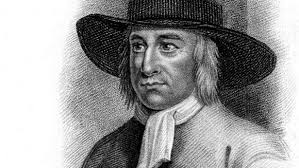
George Fox
The conversations that took place over the next week changed Mary Dyer’s life. Fox believed that men and women were equal in God’s eyes, and that each sex had the equal opportunity to spread God’s word. “God has a mission for every man, woman, and child,” Fox contended. He suggested that Mary become a Quaker elder and adopt as her mission “spreading God’s seed.” And what better place to plant his seed than in the fertile soil of the New World?
The Quakers shared beliefs that challenged existing orthodoxy. They believed God could be found in silences, in nature, in the process of individual growth. They refused to follow the customary practice of tipping their hats to superiors, believing all persons equal. They refused to take oaths to government, believing that only God was owed such uncompromised loyalty. More than enough unconventional ideas to alarm and enrage believers in orthodox and hierarchical Puritanism.
John Endecott assumed the governorship of the Massachusetts Bay Colony in 1649. He was, though it might not have seemed possible, even more intolerant than his predecessor, Governor Winthrop. For Endecott, the prospect of Quakers establishing a permanent presence in the colony, much less proselytizing, was unthinkable. When the first Quaker women arrived in Boston, they were promptly led off to jail for three weeks, then sent back to England on the next ship sailing.
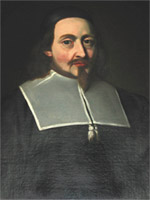
Governor John Endecott
When eight Quakers arrived in the city on August 9, 1656, Endecott knew he needed increase the deterrent. The Quakers were examined in the Massachusetts General Court and asserted their demand that they be immediately released. No law, they argued, justified their continued detention. And they were right; nothing the Quakers had done violated any law then on the books. So, Endecott realized, it was time to put something on the books.
When the General Court met in Boston in October 1656, it adopted the first of what would be a series of increasingly draconian laws meant to keep away Quakers. The 1656 law imposed a fine on the master or commander of any vessel that brought Quakers into Boston and required the Quakers to either “be brought from where they came or go to prison.” The law also called for the Quakers sent to the House of Correction to be severely whipped and kept at constant labor.
Mary Dyer was probably aware of the enactment of the anti-Quaker law when, in the late winter of 1657, she landed in Boston after an Atlantic passage that had taken her first to Barbados. Mary planned to spread the good news about Quakerism in New England--and a public ministry, unlike the holding of private religious beliefs, posed great risks. Mary and her friend and fellow Quaker, Anne Burden, both found themselves locked up in dark cells with boarded up windows for the next two and one-half months. At some point during her incarceration, she managed to slip a letter to her husband (Plimpton speculates through a crack in the window), letting him know where she was.
William Dyer made his way to Boston and headed straight for the home of Governor Endecott, where he demanded that his wife be freed. Endecott knew that Dyer, by then a prominent figure in Rhode Island politics, was held in enough esteem by Boston authorities that he would have to comply. Mary was freed on the condition she immediately leave the colony and speak to no one on her way out.
While Mary reacquainted with her family in Rhode Island, Endecott tightened the screws and stepped up persecutions of any Quakers brave or foolish enough to venture into Massachusetts. In October 1657, the General Court increased fines on Quakers and their comforters, and authorized, for males, the cutting off one ear for the first offense of re-entering the colony, a second ear cut off for a second offense, and for a third offense, “they shall have their tongues bored through with a hot iron.” Whippings were the authorized punishment for female Quakers violating the law.
In October 1658, still facing what they perceived to be a serious Quaker problem, the General Court increased punishment yet again. To deal with this “pernicious sect” that had “published and maintained many dangerous and horrid tenets,” the General Court authorized prison time, then banishment “upon pain of death.” That is, any Quaker who violated a banishment order would be executed.
In 1661, Edward Burrough published “A Declaration” of “the Sufferings of the People of God” which contained a long list of the inhumane punishments inflicted on Quakers from 1656 to 1660. They included “stripping women stark naked” and searching them “in such an inhumane manner as modesty will not permit to mention,” whippings with three-corded ropes with knots at their end “with as much strength as they could be by the arm of their executioner,” 64 imprisonments, 25 banishments, near starvations (“five kept fifteen days without food”), confinement in irons, brandings on hands, chaining to logs “in the winter time,” ears being cut off, seizure of homes, and executions.
The irrepressible Mary Dyer stayed but a brief time in Rhode Island before setting off to New Haven, perhaps hoping to win Quaker converts in that city. She was promptly “set on a horse” and ordered to leave the colony. Mary was in Providence in the summer of 1658 when she heard that three of her Quaker friends each had an ear cut off on the order of the General Court. She decided, with four female friends, to travel to Boston to protest the inhumane punishment. She and the others soon found themselves in jail.
After another few months in the bleak Boston jail, Dyer and three other Quakers who had made multiple entries into the colony (William Robinson, Marmaduke Stevenson, and Nicholas Davis) were all sentenced to “banishment upon pain of death” under the most recently enacted anti-Quaker law.
Dyer returned to Newport, but Robinson and Stevenson were again arrested for holding Quaker meetings in the woods near Salem. They faced execution for violation of the banishment order. Mary felt “called upon” to return to Boston to support her friends. Of course, Dyer was arrested—and in jail for a third, and she probably assumed, final time.
Facing Death
William Dyer composed a long letter the Court of Assistants. He called the conditions of Mary’s confinement “worse than hogs or dogs,” noting that “she had nothing to sitt or lye down upon but dust.” William argued that Mary had come to Boston not to proselytize, but only to “visit her friends in prison.” He argued that laws prohibiting travel violated basic rights: “What hath not people in America the same liberty as beasts and birds to pass the land or air without examination?” Dyer said neither God’s law nor the law of England allowed imprisonment or the punishment of death for anything Mary had done. To carry out the punishment would be “murder” and “family oppression and tyranny.”
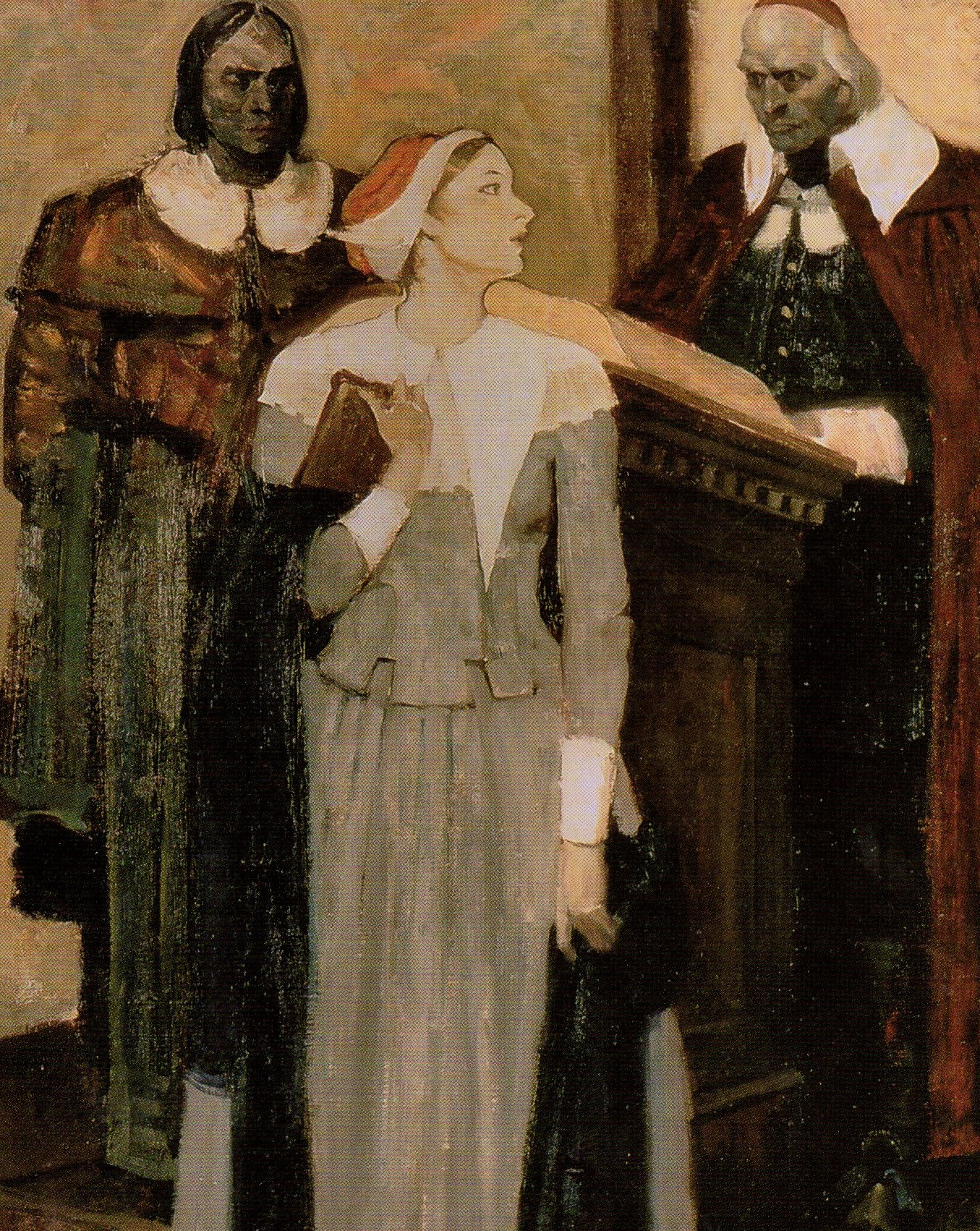
Mary Dyer confronting magistrates
On October 20, 1659, Dyer, Robinson, and Stevenson appeared before the General Court. Governor Endecott lectured the three Quakers: “We have tried several laws and endeavored in several ways to keep you from amongst us, and neither whippings, nor imprisoning, nor cutting of ears, nor banishing you upon pain of death would keep you from amongst us.” Endecott told all three they would “be hanged until you are dead.”
Dyer closed her eyes and said, “The will of the Lord be done.” Endecott said, “Take her away, Marshall!” To which Mary answered, “Yea, joyfully I go.”
Mary used the time in jail to compose a letter to the General Court. Mary wrote, “Whereas it is said by many of you that I am guilty of mine owne death by my coming as you cal it voluntarily to boston: I therefore declare unto every one that hath an eare to hear: that in the fear peace and love of god I came.”
Neither William’s letter nor Mary’s letter moved Governor Endecott to grant a reprieve. But somebody else did. In a last ditch effort to save Mary’s life, Mary’s son, William Jr., detoured on a frigate to Boston (the frigate had planned to sail directly to the Azores) to make a plea for his mother’s life. William called on the governor at his house. The governor invited a Puritan minister to join the discussion over Mary’s fate. The governor was likely well aware that there would be political costs that would come with executing a woman. Ultimately, Endecott’s power depended on the colony’s Royal Charter—and the perception that he was abusing his power could place his position or the Charter itself in jeopardy.
Ultimately, the governor and the minister settled on a plan. They would take Mary to the gallows as scheduled. They would execute her two fellow Quakers as planned. They would put a noose around Mary’s neck. And then a last-second reprieve would be announced. “She needs to experience the chill of death to get some sense in her head,” as the minister put it. Will Dyer was given the opportunity to briefly embrace his mother, then he hurried to the harbor and on towards the Azores.
On October 27, 1659, Mary began the mile-long walk from her jail cell to the gallows. She walked hand in hand between Stevenson and Robinson. It was a big production—200 or so soldiers, guns, swords, pikes, and flags flying. The captain assigned with overseeing the operation ordered soldiers to loudly beat their drums to prevent any communication between the prisoners and onlookers.
The procession came to the ladder and the tree with the hanging rope. The executioner put a rope around Robinson’s neck, as bound his hands and legs. As he was about to be turned off the ladder to his death, Robinson said, “I Suffer for Christ, in whom I live, and for whom I die.” Stevenson was next.
And then it seemed it would be Dyer’s turn. She stepped up the ladder, had her dress tied around her legs, and the rope put around her neck. Edward Burrough, in his 1661 Declaration, described what happened next:
As the Hangman was ready to turn her off, they cryed out, “Stop, for she was Reprieved,” and having loosed her feet, bad[e] her come down; but she was not forward to come down, but stood still, saying, She was there willing to suffer, as her Brethren did, unless they would null their wicked Law; but they pulled her down, and a day or two after carried her by force out of Town.
Dyer was returned temporarily to her cell, where she wrote a second letter to the General Court. “I came at His command, and I go at His command,” she said. Dyer was escorted out of Boston by four horseman, then sent onward toward the Rhode Island border.
She remained in Rhode Island for but a short period of time, then accepted an offer of neighbors, the Coddingtons, to join them on a sailing trip to Shelter Island, just off Long Island. She spent what seems to have been a few rather pleasant months on Shelter Island at the home of Nathaniel and Gissell Sylvester. She took to holding Quaker meetings in a nearby woods for both Indians and slaves. A sugar trader named John Taylor attended one of the gatherings in the woods and wrote, “[Dyer] was a comely woman and a grave matron who even shined in the image of God. We had several brave meetings there together, and the Lord’s power and preference were with us generously.”
What got Mary off of Shelter Island was word of a Declaration of the General Court, intended for an audience in London, that justified their persecution of Quakers while, at the same time, boasting of their reprieve of Dyer. She needed to set the record straight. Dyer left for Boston in late April.
When she arrived in Boston in May, she was arrested. This time, despite a letter from her husband William (“I pray give her me once agen and I…shall endeavor continually to utter my thanks and render you Love and Honor most renowned”), there would be no reprieve.
Mary’s trial (in the loosest sense of the word) was in General Court on May 31, 1660. Burrough offered an account of the examination in his pamphlet published the year after Dyer’s death:
The Governour said, “Are ye the same Mary Dyar that was here before?”
Mary Dyar, “I am the same Mary Dyar that was here the last General Court.”
The Governour said, “You will own yourself a Quaker, will you not?”
Mary Dyar: “I own myself to be so reproachfully called.”
….The Governor said, “The Sentence was passed upon her the last General Court, and now likewise; You must Return to the Prison from whence you came, and there Remain until to Morrow at Nine of the Clock, then from thence you must go to the Gallows, and there be Hanged till you are Dead.”
Mary Dyar said, “This is no more than that thou saidst before.”
“I, I,” the Governour said, “and now it is to be Executed, therefore prepare yourself to Morrow at Nine of the Clock.”
Mary Dyar answered and said, “I came in Obedience to the Will of God the last General Court, desiring you to Repeal your unrighteous Lawes of Banishment upon pain of Death; and that same is my work now, and earnest Request, because ye refused before to grant my Request, although I told you, That if ye refused to Repeal them, the Lord will send others of his Servants to Witness against them.”
John Endicot asked her, “[Are you] a Prophet?”
She said, “[I] speak the words that the Lord speaks [in me]; and now the thing is come to pass….”
Endicot said, “Away with her, away with her.”
On June 1, 1660, Mary Dyer once again was marched the one mile from her cell to a place close to Frog Pond in Boston Commons. As she walked, some in the crowd urged her to go back to Rhode Island and save her life. She yelled above the drumming, “Nay, I cannot go back to Rhode Island, for in the will of the Lord I came, and in His will I abide faithful to death.”
Mary’s last words were, “Yea, I have been in Paradise for several days and now I am about to enter eternal happiness.” As her neck snapped, a breeze billowed her skirt, causing General Humphrey Atherton to shout, “She hangs like a flag.” Many in the crowd echoed his observation.
The monarchy was restored in England three days before Mary’s hanging. Charles II was king of England. In 1661, Edward Burrough had an audience with the king. He told Charles of the Quaker persecutions in Boston and described, most likely in vivid detail, Mary’s two trips to the hanging tree. On September 9, 1661 the king issued a royal mandate commanding authorities to withhold punishment of Quakers, and to instead “send the persons over unto our kingdom of England” for disposition of their cases. In November, after reading the Royal Mandate, Governor Endecott agreed there would be no more hangings (thus sparing the life of a Quaker set to be executed the following day) and to release all Quakers then in confinement.
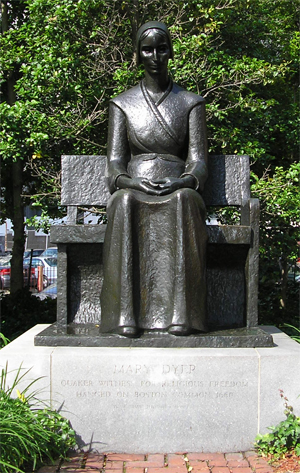
Statue of Mary Dyer at the Friends Center in Philadelphia
Endecott and the magistrates of Boston were not quite done with their mistreatment of Quakers, however. The cruel Cart and Whip Act of 1661 continued to be enforced until Endecott’s death in 1665.
In Rhode Island, however, the grand experiment of religious liberty took off. King Charles signed off in 1663 on the Rhode Island Charter. The Charter declared that “no person within the Colony, at any time hereafter, shall be in any wise molested, punished, disquieted or called into question for any difference in opinion in matters of religion, [which] do not actually disturb the peace of the Colony.” The Charter was the first document in America to grant freedom of religion.
Thanks to Johan Winsser for his helpful suggestions concerning this account.

